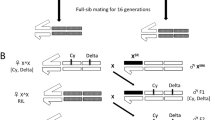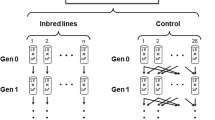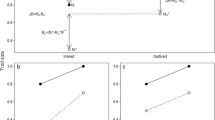Summary
Through a series of genetic load studies made on 1) samples of Drosophila willistoni from two sites in Mesitas, Colombia, it was found that the relative contributions to the total, subvital and lethal loads reflect lethal equivalences (B/A) ratios which support more the balancing theory of population structure than the neutralist theory. Moreover, measurements of population size have revealed the existance of very small demes in local populations. Under such conditions we have calculated extremely small lethal equivalence ratios in demes where probably a great deal of consanguinity takes place. We are aware that under these conditions B/A ratios cannot be very good monitors of random load measurements and, therefore, suggest a change in the mathematical formulation that take into consideration the existance of small populations.
Furthermore, it appears plausible that the degree of penetrance in the heterozygous condition changes as the population structure changes. We speculate that natural populations may have unknown selective mechanisms capable of guiding unknown dominance modifiers according to the intensity of selection.
Similar content being viewed by others
Literature
Andrewartha, H.G. (1971): Introduction to The Study of Animal Populations. Chicago: The University of Chicago Press
Band, H. (1972): Further evidence of genetic and increased developmental homeostasis in a Drosophila melanogaster natural population during a minor climatic shift. Evolution 26, 116–129
Crow, J.F.; Temin, R.G. (1964): Evidence for the partial dominance of recessive lethal genes in natural populations of Drosophila Amer. Naturalist 98, 21–33
Crow, J.F. (1968a): Some analysis of hidden variability in Drosophila In: Population Biology and Evolution (ed. Lewontin, R.), pp. 71–86. Syracuse: Syracuse University Press
Dobzhansky, Th.; Holz, A.M.; Spassky, B. (1942): Genetics of natural populations VIII. Concealed variability in the second and fourth chromosomes of Drosophila pseudoobscura and its bearing on the problem of heterosis. Genetics 27, 463–490
Dobzhansky, Th.; Wright, S. (1943): Genetics of natural populations X. Dispersion rates in Drosophila pseudoobscura. Genetics 32, 303–324
Dobzhansky, Th.; Spassky, B. (1944): Genetics of natural populations XI. Manifestation of genetic variants in Drosophila pseudoobscura in different environments. Genetics 29, 270–290
Haldane, J.B.S.; Jayakar, S.D. (1963a): Polymorphism due to selection of varying direction. J. Genet. 58, 237–242
Haldane, J.B.S.; Jayakar, S.D. (1963b): Polymorphism due to selection depending on the composition of a population. J. Genet. 58, 318–323
Hiraizumi, Y.; Crow, J.F. (1960): Heterozygous effects on viability, fertility, rate of development and longevity of Drosophila chromosomes that are lethal when homozygous. Genetics 45, 1071–1083
Hoenigsberg, H.F.; de Navas, Y.G. (1965): Population Genetics in the American Tropics I. Concealed recessives in different bioclimatic regions. Evolution 19, 506–513
Hoenigsberg, H.F. (1968): Rate of elimination of natural lethals. Amer. Naturalist 102, 185–187
Hoenigsberg, H.F.; Castro, L.E.; Granobles, L.A.; Saez. A. (1973): Population Genetics in the American Tropics IX. Rhythmic genetic changes that prove the adaptive nature of the detrimental load in Drosophila melanogaster from Caracolisito, Colombia. In: Genes, Enzymes and Populations (ed. Srb, A.M.). New York: Plenum Press
Hoenigsberg, H.F.; Palomino, J.J.; Rojas, G.G.; Lin, F.J.; Tsai, B.Y. (1977a): Population Genetics in the American Tropics XV. Islotes periféricos en las estructuras poblacionales del trópico Colombiano y Chino. Rev. Cienc. Tecn. Amer. Lat. 2001, 1, 4, 5, 7–21
Hoenigsberg, H.F.; Lin, F.J.; Tsai, B.Y.; Palomino, J.J. (1977b): Population Genetics in the American Tropics XII. A discussion on the genetic structure in founding groups of individuals in Colombia and China. Proc. 3rd Congreso Latino - americano de Genética
Hoenigsberg, H.F.; Palomino, J.J.; Hayes, M.J.; Zandstra, I.Z., Rojas, G.G. (1977c): Population Genetics in the American Tropics X. Genetic differences in Drosophila willistoni from Colombia. Evolution 31, 805–811
Hoenigsberg, H.F.; Palomino, J.J.; Chiappe, C.; Rojas, G.G.; Cañas, B.M. (1977d): Population Genetics in the American Tropics XI. Seasonal and Temporal variations in relative frequencies of Species belonging to the willistoni group in Colombia. Oecologia (Berlin) 27, 295–304
Lewontin, R.C. (1974): The Genetic Basis of Evolutionary Change. New York: Columbia University Press
Morton, N.E.; Crow, J.F.; Muller, H.J. (1956): An estimate of mutational damage in man from data on consanguineous marriages. Proc. Nat. Acad. Sci. USA. 42, 855–863
Morton, N.E. (1960): The mutational load due to detrimental genes in man. Am. J. Hum. Genet. 12, 348–364
Pavan, C.; Cordeiro, A.R.; Dobzhansky, N.; Dobzhansky, Th.; Malogolowkin, C.; Spassky, B.; Wedel, M. (1951): Concealed genetic variability in Brazilian populations of Drosophila willistoni. Genetics 36, 13–30
Spassky, B.; Dobzhansky, Th. (1950): Mutants and linkage maps in Drosophila willistoni. Heredity 4, 201–215
Stern, C.; Carson, G.; Kinst, M.; Novitski, E.; Uphoff, D. (1952): The viability of heterozygotes for lethals, Genetics 37, 413–450
Temin, R.G. (1969): Homozygous viability and fertility loads in Drosophila melanogaster. Genetics 53, 27–46
Wallace, B.; Madden, C. (1953): The frequencies of sub and supervitals in experimental populations of Drosophila melanogaster. Genetics, 38, 456–470
Wallace, B. (1966a): On the dispersal of Drosophila. Am. Nat. 100, 551–563
Wallace, B. (1968a): Topics in Population Genetics. New York: Norton and Company
Watanabe, T.K. (1969): Persistence of visible mutant in natural populations of Drosophila melanogaster. Jpn. J. Genet. 44, 15–22
Author information
Authors and Affiliations
Additional information
Communicated by R. C. Lewontin
Rights and permissions
About this article
Cite this article
Hoenigsberg, H.F., Ordoñez, M., De Polanco, M.M.E. et al. Population genetics in the American Tropics XVI. Data on partial dominance of recessives in Drosophila willistoni . Theoret. Appl. Genetics 61, 183–191 (1982). https://doi.org/10.1007/BF00273888
Received:
Accepted:
Issue Date:
DOI: https://doi.org/10.1007/BF00273888




